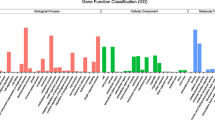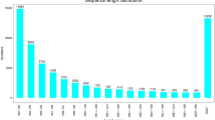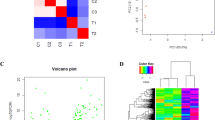Abstract
Mercury is a heavy metal which causes irreversible toxicity to fish and is detected in aquatic environment around the world. We aimed to explore the relative mechanism of mercury exposure on the brain injury. In this study, high-throughput sequencing RNA-Seq technology was carried out to analyze the changes of gene expression of brain tissues exposed to mercury. A large number of differentially expressed genes were identified. And 366 genes were up-regulated and 688 genes were down-regulated. Gene Ontology (GO) functional enrichment analysis showed that DNA-templated and transport were highly enriched in the biological process. Membrane, nucleus, and cytoplasm were highly enriched in the cellular component, and metal ion binding and DNA binding were highly enriched in molecular function. The differential genes were enriched in ferroptosis, necroptosis, calcium signaling pathway, and ion channels. Real-time quantitative reverse transcription PCR (qRT-PCR) results demonstrated the selected genes exhibited the same trends with the RNA-Seq results, which indicates the transcriptome sequencing data is reliable. Our results may provide an insightful view for the toxic effects of mercury on brain injury of common carp.






Similar content being viewed by others
Availability of Data and Materials
The data used to support the findings of this study are available from the corresponding author upon request.
References
Yu R, Yuan X, Zhao Y, Hu G, Tu X (2008) Heavy metal pollution in intertidal sediments from Quanzhou Bay, China. J Environ Sci (China) 20:664–669
Ayangbenro AS, Babalola OO (2017) A new strategy for heavy metal polluted environments: a review of microbial biosorbents. Int J Environ Res Public Health 14:94
Lu Y, Song S, Wang R, Liu Z, Meng J, Sweetman AJ et al (2015) Impacts of soil and water pollution on food safety and health risks in China. Environ Int 77:5–15
Valavanidis A, Vlahogianni T, Dassenakis M, Scoullos M (2006) Molecular biomarkers of oxidative stress in aquatic organisms in relation to toxic environmental pollutants. Ecotoxicol Environ Saf 64:178–189
Yin X, Xia L, Sun L, Luo H, Wang Y (2008) Animal excrement: a potential biomonitor of heavy metal contamination in the marine environment. Sci Total Environ 399:179–185
Sweet LI, Zelikoff JT (2001) Toxicology and immunotoxicology of mercury: a comparative review in fish and humans. J Toxicol Environ Health B Crit Rev 4:161–205
Iyengar GV, Nair PP (2000) Global outlook on nutrition and the environment: meeting the challenges of the next millennium. Sci Total Environ 249:331–346
Rice KM, Walker EM Jr, Wu M, Gillette C, Blough ER (2014) Environmental mercury and its toxic effects. J Prev Med Public Health 47:74–83
Grandjean P, Satoh H, Murata K, Eto K (2010) Adverse effects of methylmercury: environmental health research implications. Environ Health Perspect 118:1137–1145
Cargnelutti D, Tabaldi LA, Spanevello RM, de Oliveira JG, Battisti V, Redin M et al (2006) Mercury toxicity induces oxidative stress in growing cucumber seedlings. Chemosphere 65:999–1006
El-Shenawy SM, Hassan NS (2008) Comparative evaluation of the protective effect of selenium and garlic against liver and kidney damage induced by mercury chloride in the rats. Pharmacol Rep 60:199–208
Ho NY, Yang L, Legradi J, Armant O, Takamiya M, Rastegar S et al (2013) Gene responses in the central nervous system of zebrafish embryos exposed to the neurotoxicant methyl mercury. Environ Sci Technol 47:3316–3325
Powell TJ (2000) Chronic neurobehavioural effects of mercury poisoning on a group of Zulu chemical workers. Brain Inj 14:797–814
Goering PL, Morgan DL, Ali SF (2002) Effects of mercury vapor inhalation on reactive oxygen species and antioxidant enzymes in rat brain and kidney are minimal. J Appl Toxicol 22:167–172
Chen QL, Sun YL, Liu ZH, Li YW (2017) Sex-dependent effects of subacute mercuric chloride exposure on histology, antioxidant status and immune-related gene expression in the liver of adult zebrafish (Danio rerio). Chemosphere 188:1–9
Zhang QF, Li YW, Liu ZH, Chen QL (2016) Reproductive toxicity of inorganic mercury exposure in adult zebrafish: Histological damage, oxidative stress, and alterations of sex hormone and gene expression in the hypothalamic-pituitary-gonadal axis. Aquat Toxicol 177:417–424
Lefevre S, Stecyk JAW, Torp MK, Lovold LY, Sorensen C, Johansen IB et al (2017) Re-oxygenation after anoxia induces brain cell death and memory loss in the anoxia-tolerant crucian carp. J Exp Biol 220:3883–3895
Livak KJ, Schmittgen TD (2001) Analysis of relative gene expression data using real-time quantitative PCR and the 2(-Delta Delta C(T)) Method. Method 25:402–408
Baldissera MD, Souza CF, da Silva AS, Henn AS, Flores EMM, Baldisserotto B (2020) Diphenyl diselenide dietary supplementation alleviates behavior impairment and brain damage in grass carp (Ctenopharyngodon idella) exposed to methylmercury chloride. Comp Biochem Physiol C Toxicol Pharmacol 229:108674
Berntssen MH, Aatland A, Handy RD (2003) Chronic dietary mercury exposure causes oxidative stress, brain lesions, and altered behaviour in Atlantic salmon (Salmo salar) parr. Aquat Toxicol 65:55–72
Pereira P, Puga S, Cardoso V, Pinto-Ribeiro F, Raimundo J, Barata M et al (2016) Inorganic mercury accumulation in brain following waterborne exposure elicits a deficit on the number of brain cells and impairs swimming behavior in fish (white seabream-Diplodus sargus). Aquat Toxicol 170:400–412
Mieiro CL, Pacheco M, Pereira ME, Duarte AC (2009) Mercury distribution in key tissues of fish (Liza aurata) inhabiting a contaminated estuary-implications for human and ecosystem health risk assessment. J Environ Monit 11:1004–1012
Biswas S, Bellare J (2021) Adaptive mechanisms induced by sparingly soluble mercury sulfide (HgS) in zebrafish: Behavioural and proteomics analysis. Chemosphere 270:129438
Dixon SJ, Lemberg KM, Lamprecht MR, Skouta R, Zaitsev EM, Gleason CE et al (2012) Ferroptosis: an iron-dependent form of nonapoptotic cell death. Cell 149:1060–1072
Yu H, Guo P, Xie X, Wang Y, Chen G (2017) Ferroptosis, a new form of cell death, and its relationships with tumourous diseases. J Cell Mol Med 21:648–657
Weiland A, Wang Y, Wu W, Lan X, Han X, Li Q et al (2019) Ferroptosis and its role in diverse brain diseases. Mol Neurobiol 56:4880–4893
Zhang Y, Zhang P, Li Y (2022) Gut microbiota-mediated ferroptosis contributes to mercury exposure-induced brain injury in common carp. Metallomics 14(1):mfab072
Kenny EM, Fidan E, Yang Q, Anthonymuthu TS, New LA, Meyer EA et al (2019) Ferroptosis contributes to neuronal death and functional outcome after traumatic brain injury. Crit Care Med 47:410–418
Yu X, Deng Q, Bode AM, Dong Z, Cao Y (2013) The role of necroptosis, an alternative form of cell death, in cancer therapy. Expert Rev Anticancer Ther 13:883–893
Yang XS, Yi TL, Zhang S, Xu ZW, Yu ZQ, Sun HT et al (2017) Hypoxia-inducible factor-1 alpha is involved in RIP-induced necroptosis caused by in vitro and in vivo ischemic brain injury. Sci Rep 7:5818
Zhao H, Jaffer T, Eguchi S, Wang Z, Linkermann A, Ma D (2015) Role of necroptosis in the pathogenesis of solid organ injury. Cell Death Dis 6:e1975
Jackson WF (2000) Ion channels and vascular tone. Hypertension 35:173–178
Collingridge GL, Olsen RW, Peters J, Spedding M (2009) A nomenclature for ligand-gated ion channels. Neuropharmacology. 56:2–5
Prevarskaya N, Skryma R, Shuba Y (2010) Ion channels and the hallmarks of cancer. Trends Mol Med 16:107–121
Lin H, Bhatia R, Lal R (2001) Amyloid beta protein forms ion channels: implications for Alzheimer's disease pathophysiology. FASEB J 15:2433–2444
Xiong ZG, Chu XP, Simon RP (2007) Acid sensing ion channels--novel therapeutic targets for ischemic brain injury. Front Biosci 12:1376–1386
Belkacemi L, Bedard I, Simoneau L, Lafond J (2005) Calcium channels, transporters and exchangers in placenta: a review. Cell Calcium 37:1–8
Sather WA, McCleskey EW (2003) Permeation and selectivity in calcium channels. Annu Rev Physiol 65:133–159
Lashgari R, Motamedi F, Zahedi Asl S, Shahidi S, Komaki A (2006) Behavioral and electrophysiological studies of chronic oral administration of L-type calcium channel blocker verapamil on learning and memory in rats. Behav Brain Res 171:324–328
Funding
The work was supported by the National Natural Science Foundation of China (no.30972191), Jilin Province Industrial Technology Research and Development Special Project (no.2019C059-5), and Jilin Province Science and Technology Development Plan Project (no.20190201179JC).
Author information
Authors and Affiliations
Contributions
Y. Z. and Y.L. designed the experiment; Y.Z., P. Z., S.X., and L.Y did the experiment; Y. Z. wrote the paper.
Corresponding author
Ethics declarations
Ethics Approval and Consent to Participate
All the experimental protocols in this study were approved by the Institutional Animal Care and Use Committee of Jilin Agricultural University.
Consent for Publication
All authors agreed to submit it in its current form for consideration for publication in the journal.
Competing interests
The authors declare no competing interests.
Additional information
Publisher’s Note
Springer Nature remains neutral with regard to jurisdictional claims in published maps and institutional affiliations.
Supplementary Information

ESM 1
Supplement Fig. 1 Mercury accumulation in blood and brain tissues. The data are showed as mean ± SD (n = 3). P < 0.05 indicates a significant difference between the two groups (PNG 25 kb)
Rights and permissions
About this article
Cite this article
Zhang, Y., Lu, Y., Zhang, P. et al. Brain Injury Induced by Mercury in Common Carp: Novel Insight from Transcriptome Analysis. Biol Trace Elem Res 201, 403–411 (2023). https://doi.org/10.1007/s12011-022-03161-2
Received:
Accepted:
Published:
Issue Date:
DOI: https://doi.org/10.1007/s12011-022-03161-2




